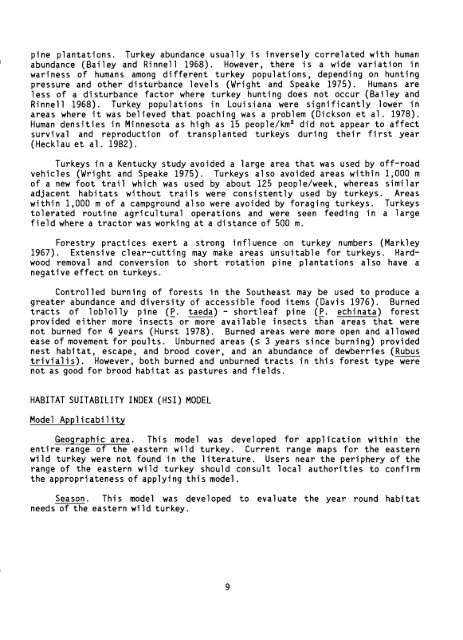habitat suitability index models: eastern wild turkey - USGS National ...
habitat suitability index models: eastern wild turkey - USGS National ...
habitat suitability index models: eastern wild turkey - USGS National ...
You also want an ePaper? Increase the reach of your titles
YUMPU automatically turns print PDFs into web optimized ePapers that Google loves.
pine plantations. Turkey abundance usually is inversely correlated with human<br />
abundance (Bailey and Rinnell 1968). However, there is a wide variation in<br />
wariness of humans among different <strong>turkey</strong> populations, depending on hunting<br />
pressure and other disturbance level s (Wright and Speake 1975). Humans are<br />
less of a disturbance factor where <strong>turkey</strong> hunting does not occur (Bailey and<br />
Rinnell 1968). Turkey populations in Louisiana were significantly lower in<br />
areas where it was believed that poaching was a problem (Dickson et al. 1978).<br />
Human densities in Minnesota as high as 15 people/km 2 did not appear to affect<br />
survi va1 and reproduction of transplanted <strong>turkey</strong>s duri ng thei r fi rst year<br />
(Hecklau et al. 1982).<br />
Turkeys in a Kentucky study avoided a large area that was used by off-road<br />
vehicles (Wright and Speake 1975). Turkeys also avoided areas within 1,000 m<br />
of a new foot trail which was used by about 125 people/week, whereas similar<br />
adjacent <strong>habitat</strong>s without trails were consistently used by <strong>turkey</strong>s. Areas<br />
within 1,000 m of a campground also were avoided by foraging <strong>turkey</strong>s. Turkeys<br />
tolerated routine agricultural operations and were seen feeding in a large<br />
field where a tractor was working at a distance of 500 m.<br />
Forestry practices exert a strong i nfl uence on <strong>turkey</strong> numbers (Markley<br />
1967). Extensive clear-cutting may make areas unsuitable for <strong>turkey</strong>s. Hardwood<br />
removal and conversion to short rotation pine plantations also have a<br />
negative effect on <strong>turkey</strong>s.<br />
Controlled burning of forests in the Southeast may be used to produce a<br />
greater abundance and diversity of accessible food items (Davis 1976). Burned<br />
tracts of loblolly pine (P. taeda) - shortleaf pine (P. echinata) forest<br />
provided either more insects or more available insects than areas that were<br />
not burned for 4 years (Hurst 1978). Burned areas were more open and allowed<br />
ease of movement for poults. Unburned areas (s 3 years since burning) provided<br />
nest <strong>habitat</strong>, escape, and brood cover, and an abundance of dewberries (Rubus<br />
trivialis). However, both burned and unburned tracts in this forest type were<br />
not as good for brood <strong>habitat</strong> as pastures and fields.<br />
HABITAT SUITABILITY INDEX (HSI) MODEL<br />
Model Applicability<br />
Geographi c area. This model was developed for app1i cati on wi thi n the<br />
entire range of the <strong>eastern</strong> <strong>wild</strong> <strong>turkey</strong>. Current range maps for the <strong>eastern</strong><br />
<strong>wild</strong> <strong>turkey</strong> were not found in the literature. Users near the periphery of the<br />
range of the <strong>eastern</strong> <strong>wild</strong> <strong>turkey</strong> should consult local authorities to confirm<br />
the appropriateness of applying this model.<br />
Season. This model was developed to evaluate the year round <strong>habitat</strong><br />
needs of the <strong>eastern</strong> <strong>wild</strong> <strong>turkey</strong>.<br />
9

















